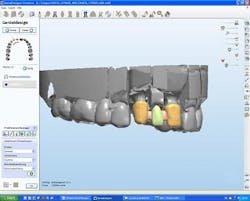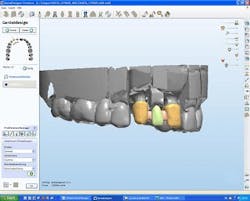Creating dentures with laser additive manufacturing
Lichtenfels, Germany - Most dental restorations use conventional techniques such as mold-based casting or milling from the complete workpiece, with milling currently being the most widely used technique. These manufacturing methods have weaknesses in terms of quality, take time, and cost approximately $26 for a milled unit.
But working with laser additive manufacturing (LAM) technology from Concept Laser, dental laboratory Laufer Zahntechnik GmbH (Mannheim, Germany) says it can create dentures for just $13 -- half the cost of milled versions.
"Laser CUSING" combines the letter C in the company's name, and the word fusing, as in complete melting. The patented process generates layer-by-layer buildup in an "island principle" where islands are worked in succession, producing a reduced stress component that allows solid and large parts to be generated with low distortion.
Laufer Zahntechnik works with a MLAB laser CUSING system, and CAMbridge software to automatically generate and position the crowns and bridges on the build plate. With fully automatic generative fabrication, on average 80 units are fabricated simultaneously on one build plate per day; these batch sizes generate enormous cost advantages. Also, labor costs are significantly reduced -- instead of employing 6 to 7 dental technicians for completely conventional cast fabrication, only 4 employees are now required to produce the same quantity of product using the generative metal laser melting process.
Fully automatic fabrication overnight not only speeds up the technical production time itself, but also offers enormous savings of time for dentists as service partners. An impression of the patient can be taken in the morning and sent it to the laboratory. At Laufer the associated plaster-cast model is then created and scanned in, and the denture is designed. By the end of the working day the build job prepared with CAMbridge is started on the Mlab cusing machine, and fabrication takes place fully automatically overnight. The next morning, the denture parts are subjected to a heat treatment at Laufer and then detached from the build plate. After certain finishing and veneer processes, dentists can insert the dentures into the mouths of their patients in the space of two days.
Laufer's range of customers now includes around 500 dental practices.

